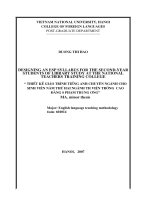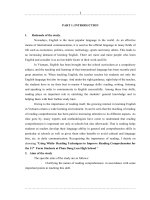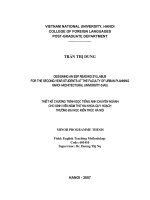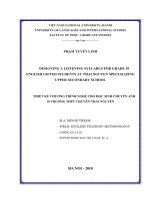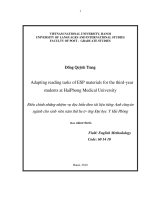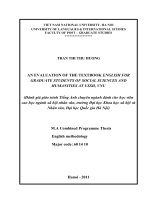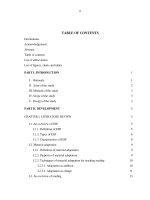Designing an ESP syllabus for the second-year Nursing students at Tuyen Quang medical vocational school = Thiết kế chương trình tiếng Anh chuyên ngành cho học s
Bạn đang xem bản rút gọn của tài liệu. Xem và tải ngay bản đầy đủ của tài liệu tại đây (1.77 MB, 69 trang )
2
VIET NAM NATIONAL UNIVERSITY, HANOI
UNIVERSITY OF LANGUAGES AND INTERNATIONAL STUDIES
FACULTY OF POST-GRADUATE STUDIES
*****************
TỐNG THỊ THANH HƯỜNG
DESIGNING AN ESP SYLLABUS
FOR THE SECOND-YEAR NURSING STUDENTS AT
TUYEN QUANG MEDICAL VOCATIONAL SCHOOL
THIẾT KẾ CHƯƠNG TRÌNH TIẾNG ANH CHUYÊN NGÀNH
CHO HỌC SINH NGÀNH Y TÁ, ĐIỀU DƯỠNG NĂM THỨ HAI
TRƯỜNG TRUNG CẤP Y TẾ TUYÊN QUANG
M.A. MINOR THESIS
Field: English Teaching Methodology
Code: 60 14 10
SUPERVISOR: NGUYỄN THỤY PHƯƠNG LAN, M.A
HANOI, 2011
6
TABLE OF CONTENTS
Declaration…………………………………………….………….… …………………………
i
Acknowledgments………………………………………………………….……………………
ii
Abstract………………………………… ……………………………….………………………
iii
Table of contents……………………… …………………………………….…………………
iv
List of abbreviations……………………….……………………………….…………………
vii
List of tables and figures ………………………………………………….… ………………
viii
PART A: INTRODUCTION………… ….……………………….……….…… …
1. Rationale ……………………………… ….……………………… …………
2. Aim of the study……………………… …….…………………………………
3. Scope of the study ………………………… ………… ……… ……………
4. Methods of the study……………………………… ….… …….… …………
5. Significance of the study………………………… ……….……… …………
6. Design of the study ……………………………… …………………………
1
1
2
2
3
3
4
PART B: DEVELOPMENT………… ….……………… ….……………………
CHAPTER 1. LITERATURE REVIEW……………………….………………………
1.1. An overview of ESP……………………………………….……………… ……
1.1.1. Definitions of ESP…………………………………………………… ……
1.1.2. Types of ESP……………………………………………………….… ……
1.1.3. ESP teacher’s role in course design ………………… ….…………… ……
1.2. Current views on ESP syllabus design………………….………… ……
1.2.1. Definitions of syllabus……………………………………… …….….……
1.2.2. Approaches to ESP syllabus design…………………………… … ………
1.2.2.1. A language-centered approach…………………………… …… ……
1.2.2.2. A skill-centered approach………………………………… ….… ……
1.2.2.3. A learning-centered approach……………………………… … ……
1.2.3. Types of syllabus………………………………………………….…….… …
1.2.3.1. Content – based syllabus………………………………… … ………
1.2.3.2. Skill – based syllabus………………………….………… ……………
1.2.3.3. Method – based syllabus……………………………….…… …………
5
5
5
5
6
7
8
8
9
9
10
10
10
11
12
12
7
1.2.4. Steps to syllabus design……………………… ……… …………………….
1.2.4.1. Needs analysis in syllabus design…………………………….…………
1.2.4.2. Goals and Objectives of the syllabus……………………… …………
1.2.4.3. Selection of content………… …………………………….……………
1.2.4.4. Syllabus organization…………………………….……………… ……
1.3. Summary…………………………………………………………………………
CHAPTER 2. NEEDS ANALYSIS AT TUYEN QUANG MEDICAL
VOCATIONAL SCHOOL………… ….…….……………………………….………
2.1. The ESP teaching and learning situation at Tuyen Quang Medical
Vocational School………… ….……………… …………………………………….
2.1.1. The teaching staff…………………… ……………… ……………………
2.1.2. The students…………………………………………… …………………….
2.1.3. The materials…………………………………………….… ………………
2.2. The study………… ….……………… ……………… …….………………….
2.2.1. The subjects…………………………………… ……… …………………
2.2.2. Instruments for collecting data…………………………….…………………
2.2.3. Data analysis and major findings……………………… ……………………
2.2.3.1. Data from Questionnaires……………………… … …………
2.2.3.1.1. Course objectives……….…………… … … ….…………
2.2.3.1.2. Main tasks for a nurse…………………….…… … ……………….
2.2.3.1.3. Skills for a nurse to fill the main tasks………… …………………
2.2.3.1.4. Language skills and learning activities………… … ……… ……
2.2.3.2. Data from Interviews………………………… … …………………
2.2.3.2.1. Language skills and learning activities ………….….….……………
2.2.3.2.2. Time allotment for the ENP course…… …… …… ….…………
2.2.3.3. Major findings……………………….… …………… … …………
14
14
15
16
17
18
19
19
20
20
21
22
22
22
23
23
23
26
29
30
33
33
34
34
36
8
CHAPTER 3. DESIGNING AN ESP SYLLABUS FOR THE SECOND-YEAR
NURSING STUDENTS AT TUYEN QUANG MEDICAL VOCATIONAL SCHOOL
3.1. Aims and Objectives of the syllabus……………………… …….……………
3.2. Content specification……………………… ………… ……….…… …… …
3.2.1. Topics in the syllabus……………………… ………….…………………….
3.2.2. Language skills and learning tasks………………….……… …… … ……
3.2.3. Functions in the syllabus……………………………… ……………………
3.3. Timing of the syllabus ……………………… …………… …………….……
3.4. Syllabus organization……………………… …………………….………… …
3.5. The proposed ESP syllabus for the 2nd year nursing students at Tuyen
Quang Medical Vocational School……………………… ………………………….
3.6. Summary……………………… ……………………………… ………………
36
36
37
37
38
38
38
39
39
PART C: CONCLUSION…………………….… ……………………………… …
1. Summary of the study ……………………………… …………………………
2. Limitation and suggestion for further study…….……………………… ……
40
40
41
REFERENCES
APPENDICES
A SAMPLE UNIT
9
LIST OF ABBREVIATIONS
TQMVS
Tuyen Quang Medical Vocational School
GE
General English
ESP
English for specific purposes
ENP
English for nursing purposes
EAP
English for Academic Purposes
EOP
English for Occupational Purposes
MOET
Vietnam Ministry of Education and Training
10
LIST OF TABLES AND FIGURES
Figure 1.1: ESP classification by professional area
6
Table 2.1: The students’ & graduates’ ranking the course objectives in order of
importance
25
Table 2.2: The students’ (S), graduates’ (G) and subject teachers’ (T) ranking
the necessity of nursing tasks
28
Figure 2.1: Subject teachers’ perception of the necessity of skills for a nurse
29
Figure 2.2: Students’ wants of language skills for the course.
30
Figure 2.3: Student’ ranking of the importance of language skills
31
Table 2.3: Students’ wants of learning activities or tasks.
32
11
PART A: INTRODUCTION
1. Rationale
Teaching English for Specific Purposes (ESP) has developed rapidly since the
development of the globalization. People with good English proficiency are extensively
needed in many areas, such as, tourism, economics, nursing, banking, etc. In Vietnam, ESP
teaching and learning are getting more and more attention in order to provide students the
best preparation for their future career to meet the growing demand for professional
communication.
ESP is a compulsory subject in the teaching curriculum for students at Tuyen
Quang Medical Vocational School (TQMVS) and it has been taught there for a few years.
However, the ESP teaching and learning at TQMVS has experienced a number of
difficulties such as lack of materials, inappropriate contents, lack of experienced ESP
teachers and so on. Among these, the lack of an appropriate ESP course book for the
nursing students seems to be most urgent because the current course book, a teacher self-
made material without surveying or analyzing students‟ needs has revealed unsuitable to its
learners. Moreover, English for Nursing Purpose (ENP) materials are either not very
available in Vietnam or too difficult for my students to learn due to their low English
proficiency.
To enhance the quality of ESP teaching and learning to meet the demands of
students in the globalization of trade and economy, it is necessary to carefully consider
ESP materials as well as teachers‟ methodologies, facilities for teaching, teachers‟ and
students‟ difficulties in ESP teaching and learning. Indeed, “materials are significant in the
ESP context” because they are used “as a source of language, as a learning support, for
motivation and stimulation, and for reference” (Dudley-Evans and Jo St John, 1998:170).
Therefore, priority must be given to developing materials.
12
Furthermore, it is suggested that “teaching materials should have relevance to the
learning goals and be of appropriate difficulty level to the students concerned, a variety of
learning tasks should be presented properly with realistic goals and effective strategies in
reaching those goals” (Ames, 1992; Dornyei & Csizer, 1998, McMillan & Forsyth, 1991,
cited in Wang, 2007: 3). As such, the design of a suitable material or course book which
meets learners‟ specific learning objectives, level of proficiency, needs, wants and lacks
plays a very crucial role in the success of an English course.
Because of the above reasons, I choose “Designing an ESP Syllabus for the
Second-year nursing Students at Tuyen Quang Medical Vocational School” as the theme of
my minor thesis. It is hoped that the study can be the point of departure in solving one of
the problems facing ESP teachers at TQMVS, be beneficial to both the ESP teachers and
the students at TQMVS, and make contribution to the growing understanding of ESP
teaching which is very important to the nursing students.
2. Aim & Objectives of the study
The study aims at designing an appropriate ESP syllabus for the 2
nd
year nursing
students at TQMVS. To achieve this aim, the following objectives are set to be obtained:
(1) To identify the 2
nd
year nursing students‟ needs as perceived by ESP teachers, ESP
students, subject teachers and graduates.
(2) To propose an appropriate ESP syllabus for the target students based on the relevant
theories and the Needs Analysis.
To achieve the aim & objectives, the following research questions are to be answered:
1) What are the students‟ needs as perceived by the ESP teachers, ESP students, subject
teachers and graduates?
2) What should be included in the ESP syllabus for the 2
nd
year nursing students at
TQMVS as perceived by the ESP teachers, ESP students, subject teachers and
graduates?
13
3. Scope of the study
The study limits itself to design an ESP syllabus of elementary level in English for
the 2
nd
year nursing students at TQMVS. The author of the study is concerned with the 2
nd
year nursing students who are being trained to reach the intermediate level in nursing,
subject teachers, teachers of ESP and graduate students at TQMVS. Other approaches to
syllabus design intended for students and other subjects at any other levels of English
language proficiency would be beyond the scope.
4. Methods of the study
A survey approach was conducted for this research with questionnaires and
interviews. Three questionnaires were administered to the targeted students, graduate
students and subject teachers. The questionnaires aims at exploring the students‟ needs and
expectations of the ESP course; particularly identifying useful topics for the syllabus,
appropriate language skills and learning activities for the course; and finding out the
required ESP for TQMVS graduates in their future workplace. Interviews were also
conducted to elicit appropriate language skills, learning tasks and activities for the course
from 3 ESP teachers. Additionally, informal interviews with the students, the subject
teachers and the graduates were also touched on in order to clarify and supplement
information collected from survey questionnaires. In this study, therefore, both quantitative
and qualitative methods were employed.
5. Significance of the study
The study is hoped to be beneficial to both the ESP teachers and the nursing
students at TQMVS in several ways. First, it increases the knowledge and understanding of
individual English teachers regarding the importance of ESP syllabus design. Second, it
sets up an ESP syllabus that is urgently necessary for the 2
nd
year nursing students at
TQMVS. Third, it helps the teachers understand the students‟ needs, interests in ESP
learning and, therefore, can adjust their ways of teaching the ESP subject and provide their
students opportunities to learn.
14
6. Design of the study
The study consists of three parts:
Part A (Introduction) presents the rationale, the aim, the scope, the method, the
significance, and the design of the study.
Part B (Development) consists of three chapters:
- Chapter 1 reviews the related theoretical background such as definitions of ESP
and syllabus, approaches to ESP syllabus design and types of syllabus.
- Chapter 2 describes current ESP teaching and learning situation at TQMVS, data
collection instruments and analysis of the results.
- Chapter 3 proposes an ESP syllabus for the 2nd year nursing students at TQMVS.
Part C (Conclusion) gives some conclusions on the research and makes suggestions
for further study.
15
PART B: DEVELOPMENT
CHAPTER 1: LITERATURE REVIEW
This chapter looks into definitions of ESP, types of ESP, and the role of ESP
teacher in course design. This chapter also focuses on exploring various approaches to ESP
syllabus design, different types of syllabus, steps in syllabus design in which analyzing
needs is considered as the starting step.
1.1. AN OVERVIEW OF ESP
1.1.1. Definitions of ESP
Many authors have defined ESP so far. Hutchinson & Waters (1987:19) theorize
“ESP is an approach to language teaching in which all decisions as to content and method
are based on the learner‟s reason for learning” and state that “the foundation of all ESP is
the simple question: Why does this learner need to learn a foreign language?”. This means
that ESP teaching should be really based on learner need, the language required and the
learning context.
Dudley-Evans and St John (1998:4) gave an extended definition of ESP in terms of
“absolute” and “variable” characteristics:
* Absolute characteristics:
1. ESP is defined to meet specific needs of learners;
2. ESP makes use of the underlying methodology and activities of the discipline it
serves;
3. ESP is centered on the language (grammar, lexis, register), skills, discourse and
genres appropriate to these activities.
* Variable characteristics:
1. ESP may be related to or designed for specific disciplines;
2. ESP may use, in specific teaching situations, a different methodology from that
of general English;
16
3. ESP is likely to be designed for adult learners, either at tertiary level institution
or in a professional work situation. It could, however, be for learners at
secondary school level;
4. ESP is generally designed for intermediate or advanced students;
5. Most ESP course assume some basic knowledge of the language systems, but it
can be used with beginners.
From the above definitions of ESP, it can be said that teaching ESP must be based on
learners‟ needs.
1.1.2. Types of ESP
The two main types of ESP that have traditionally been divided by famous authors
are English for Academic Purposes (EAP) and English for Occupational Purposes (EOP)
(Robinson 1991: 3-4; Dudley-Evans and Jo St John 1998: 6; Strevens, 1977a). The former
involves work-related needs and training while the later involves academic study. They are
further divided in terms of discipline or professional area (as can be seen from figure 1.1
below).
Figure 1.1. ESP classification by professional area
(Dudley-Evans and Jo St John, 1998:6)
English for Specific Purposes
English for Occupational Purposes
English for Academic purposes
English
for
(Acade-
mic)
Science
and
Techno-
logy
English
for
(Acade-
mic)
Medical
Purposes
English
for
(Acade-
mic)
Legal
Purposes
English
for
Manage-
ment,
Finance
and
Econo-
mics
English for
Professional
Purposes
English for
Vocational
Purposes
English
for
Medical
Purposes
English
for
Business
Purposes
Pre-
vocation
-al
English
Vocation
-al
English
17
Hutchinson & Waters (1987: 16-17) propose “tree of ELT” in which ESP is divided
into 3 branches: English for Science & Technology (EST); English for Business &
Economics (EBE) and English for Social Sciences (ESS). Then each of these three main
areas is subdivided into 2 branches: English for Academic Purposes (EAP) and English for
Occupational Purposes (EOP). These two types of ESP “differentiated according to
whether the learner requires English for academic study (EAP) or for work/ training
(EOP)”. However, they emphasize that there is “not a clear cut distinction” between EAP
and EOP because “people can work and study simultaneously; it is also likely that in many
cases the language learnt for immediate use in a study environment will be used later when
the student takes up, or returns to, a job”.
In short, studying various types of ESP is an important step that provides a teacher
with an overall picture of the group of learners he is going to work with. It is also helpful
for ESP teachers in making needs analysis and designing a suitable syllabus for their
students. English for Nursing purposes belongs to English for Medical Purposes and my
viewpoint is that my nursing students should be taught English for work to help them
perform better in their future workplace.
1.1.3. ESP teacher’s role in course design
The role of ESP teachers as a course designer and material provider has been
pointed out by various linguists. Hutchinson & Waters (1987: 157) state that “it is likely
that in addition to the normal functions of a classroom teacher, the ESP teacher will have
to deal with need analysis, syllabus design, materials writing or adaptation and evaluation”.
Similarly, Dudley-Evans and Jo St John (1998: 13) point out five key roles that an ESP
practitioner should take: as a teacher; a course designer and materials provider; a
collaborator; a researcher; and an evaluator. Dudley-Evans and Jo St John (1998: 15) also
claim: “The role of ESP teachers as „providers of material‟ involves (1) choosing suitable
published materials (2) adapting material when published material is not suitable (3) or
even writing material where nothing suitable exits”.
There are several reasons why an ESP teacher should involve course design.
Dudley-Evans and Jo St John (1998:14) explain: “it is rarely possible to use a particular
textbook without the need for supplementary material, and sometimes no really suitable
18
published material exists for certain of the identified needs”. Richards (2007:256 cited in
Zohrabi, 2008: 57) argues that “A book may be ideal in one situation, however, it may be
rather not useful in a different situation”. When stressing the role of the ESP teacher in
course design, Hutchinson and Waters (1987: 107) believe that “the process of materials
writing may help to make teachers more aware of what is involved in teaching and
learning” and it is the ESP teacher who most understands his teaching context such as
students‟ proficiency level, motivation, institutional requirement, and so on.
In sum, ESP teachers have an important role in designing a course with an aim to
fit the needs of a specific group of learners. As an ESP teacher, I adopt the above authors‟
view that ESP teachers are required to do more than simply teaching a language, i.e. they
should take up in writing or adapting materials to fill the specific needs of their students so
that they can improve the ESP teaching and learning quality at their institutions. This view
has inspired me to design an ESP syllabus, an important document in the teaching and
learning process.
1.2. CURRENT VIEWS ON ESP SYLLABUS DESIGN
1.2.1. Definitions of syllabus
Syllabus is defined by different writers in broad view and narrow view.
Yalden (1987:86) holds a broad view of syllabus in stating that “It replaces the
concept of method. The syllabus is now seen as an instrument by which the teacher, with
the help of the syllabus designer, can achieve a certain coincidence between the needs and
aims of the learner, and the activities that will take place in the classroom”. To advocate
this opinion, Been (1984:61, cited in Nunan, 1988: 6) points out: “Any syllabus will
express, however indirectly, certain assumptions about language, about the psychological
process of learning, and about the pedagogic and social process within a classroom”.
Obviously, authors advocating the broad view believe that syllabus and methods should
not be kept separate and argue that with the advent of communicative language teaching
the distinction between content and tasks is difficult to sustain.
19
On the other hand, the narrow view argues that there should be a clear distinction
between syllabus design and methodology. For them, syllabus design is concerned with the
selection and grading content, while methodology is concerned with the selection of
learning tasks and activities. In Nunan‟s (1988:6) words, “a syllabus is a statement of
content which is used as the basis for planning courses of various kinds, and that the task
of the syllabus designer is to select and grade this content” and “syllabus focuses more
narrowly on the selection and grading of content” (p8). Sharing Nunan‟s view, Hutchinson
and Waters (1987: 80) also indicate that “A syllabus is a document which says what will
(or at least should) be learnt”. Clearly, all these authors reveal syllabus in terms of the
selection and grading content.
In brief, different definitions of syllabus are derived from different views of the
connection between syllabus and methodology, i.e. some linguists consider syllabus and
methodology as separate options, others think otherwise. Therefore, it is essential for the
designer to decide on which view to follow when designing a syllabus. In this study with a
focus on the content of learning and its organization, the author adopts the narrow view as
a point of departure to design a syllabus for the 2
nd
year nursing students at TQMVS.
1.2.2. Approaches to ESP syllabus design
Hutchinson and Waters (1987: 65) identified three main types of approaches to
course design or approaches to ESP syllabus design: (a) A language-centred approach, (b)
A skill-centred approach and (c) A learning-centred approach.
1.2.2.1. A language-centred approach
This approach is probably the simplest and most common in ESP. Its course design
process starts with the learner, proceeds through various stages of analysis to a syllabus,
then to materials in use in the classroom and finally to evaluation of mastery of the
syllabus items. The connection between the analysis of the target situation and the content
of the ESP course is the main objective of this approach. Though perceived as a very
logical and straightforward procedure, it has a number of weaknesses. Firstly, only a
restricted area of the language is taught. Secondly, it seems to be static and inflexible.
Thirdly, it does not acknowledge the important factors contributing to the creation of any
20
course. Finally, its analysis of target situation data is only at the surface level and as such
reveals little about the competence that underlies the performance.
1.2.2.2. A skill-centred approach
A skill-centred approach aims to reveal the competence that underlies the
performance. With the view that an ESP course helps learners to develop skills and
strategies which will continue to develop after the ESP course, this approach aims at not
only providing learners with a certain amount of specific linguistic knowledge but also
making them into better processors of information. Therefore, in this approach learners are
taken into more consideration than in the language-centred approach. However, this
approach still sees the learner as a user of language rather than as a learner of language
and it is concerned with the processes of language use not of language learning.
1.2.2.3. A learning-centred approach
The learning-centred approach is based on the recognition of the complexity of the
learning process in which learners is not the only one factor to be considered. When
designing a syllabus in a learning-centred approach, the methodology must be considered
right from the start. It cannot be just decided on to the end of an existing selection of
syllabus items and texts. A learning-centred approach takes account of the learner at every
stage of the design process. It really wants to discover not the competence that enables
someone to perform itself but how someone acquires that competence.
After a careful consideration about different approaches to syllabus design, the
learning-centred approach is chosen as the basis for designing an ESP syllabus for the 2
nd
nursing students at TQMVS.
1.2.3. Types of syllabus
There are many types of syllabus and approaches to syllabus classification
mentioned by different authors. So far, Robinson‟s (1991) classification of language
syllabi into three main types: content-based syllabus, skill-based syllabus and method-
based syllabus seems to be the more common to language teachers.
21
1.2.3.1. Content-based syllabus
1.2.3.1.1. Language form syllabuses (structural/grammatical syllabus)
This syllabus is based on the assumption that language consists of a finite set of
rules which can be combined in various ways to make meaning. So the focus of this
syllabus type is the grammatical structure of the language. The syllabus input is selected
and graded according to grammatical notions of simplicity and complexity. The learner is
expected to master each structural step, add it to her grammar collection, then use it
automatically in genuine communication outside the classroom. However, “structurally
graded syllabus misrepresented the complex nature of language as a system and tended to
focus on only one aspect of language, that is formal grammar” (Nunan, 1988:30).
1.2.3.1.2. Functional/ Notional syllabus
The functional/notional syllabus can be considered as the first alternative to the
structural syllabus because it takes into account the desired communicative capacity as it
combines the functional aspect (communicative purposes for which we language, e.g.
requesting, complaining, apologizing, etc.) and notional or conceptual aspect (time, space,
movement, cause and effect, etc.). The benefit of this syllabus is that “It sets realistic
learning tasks, and provides for the teaching of everyday, real-world language”
(Finocchiaro and Brumfit, 1983:17, cited in Nunan, 1988:36). However, there are
difficulties of selecting and grading function and form due to the lack of explicit criteria
(Nunan, 1988: 36).
1.2.3.1.3. Situational syllabus
The situational syllabus is underpinned by the assumption that “language is always
used in social context and cannot be fully understood without reference to that context”
(Wilkins, 1976:16). Thus, the principal organizing feature is a list of real or imaginary
situations that the learners will to have to deal with in real life. The situational syllabus has
an advantage of teaching language of intermediate practical use in context and it is
“learner-rather than subject-centred” (Wilkins, 1976:16). However, this syllabus presents
some drawbacks. First, the grading situations in terms of difficulty or need to be learn
22
before is rather complex. Second, language used in a specific situation may not transfer to
another.
1.2.3.1.4. Topic-based syllabus (Theme-based syllabus)
Topic syllabus is organized by topics or themes which are selected by the
textbook writers on the basis of their perception on the importance of the topics to its
learners‟ lives. In designing a topic-based syllabus, it is theme which is the point of
departure rather than grammar or situations. The main advantage of this syllabus is that “it
motivates the students and as a basis for the syllabus of the language forms, functions or
whatever the course designers wish to focus on” (Robinson, 1991:37). This syllabus is, in
general, of great importance to ESP because it helps “deploy the content of the student‟s
work or specialist study. One objective of the ESP course may, in fact, be to teach his
specialist content” (Robinson, 1991: 36). Beside the above advantages, this type of
syllabus also reveals a problem of grading as argued by Nunan (1988:49) that “the logic of
the subject may provide a non-linguistic rationale for the selecting and the grading
content”.
1.2.3.2. Skill-based syllabus
The content of language teaching in this syllabus is a collection of particular skills
that may play a role in using language. Skill-based syllabus combines linguistic
competences (pronunciation, vocabulary, grammar and discourse) and generalized types of
behavior, such as listening to spoken language for the main ideas, writing well-formed
paragraphs, giving effective oral presentations, and so on. This syllabus focuses on helping
learners to develop specific language skills and strategies as well as to develop more
general competence in the language. However, it has been criticized for focusing on
discrete aspects of performance rather than on developing more global and integrated
communicative abilities.
1.2.3.3. Method-based syllabus
1.2.3.3.1. Task-based syllabus
Task-based syllabus is “one that is organized around tasks that students will complete
in the target language” (Richards, 2001:161). The syllabus consists of “a set of tasks or
23
activities ordered according to cognitive difficulty” (Robinson, 1991:39). A task is “an
activity which requires learners to use language, with emphasis on meaning, to attain an
objective” (Bygate, Skehan, and Swain, 2001 cited in Ellis, 2003:5). Besides this
definition, „tasks‟ are also defined differently by various linguists. However, no matter
what „tasks‟ are defined, the aim of task-based syllabus is to help learners draw on a
variety of language forms, functions and skills in completing the tasks, and to stimulate
real communication in the target language. Thus, this type of syllabus represents “a
particular realization of Communicative Language Teaching” (Celce-Murcia, 2001:62).
The benefit of this syllabus is that “language learning-teaching activities basing on
tasks enable the teachers to modify their methods to suit different levels of proficiency and
taste” (Zohrabi, 2008:57). For ESP, this syllabus is of great importance because “tasks
serve as a suitable unit for specifying learners‟ needs and thus for designing specific
purpose courses” (Ellis, 2003:209) and ESP learners‟ need is that “using the medium of
English, they should successfully perform work of a study task” (Robinson, 1991:40).
1.2.3.3.2. Process syllabus
Negotiation between the students and the teachers is the main characteristic of this
approach (Robinson, 1991:38). In developing a process syllabus, tasks and activities are
designed and planned in advance but not the linguistic content. As such, the designer no
longer pre-selects learning content, but provides a framework for teacher and learners to
create their own on-going syllabus in the classroom. Process syllabus can be seen as an
innovative one for its focus on project work and problem-solving tasks and activities.
However, it is seen as synonymous with task-based one because they share a concern with
“classroom processes”, “specification of tasks” and “learners‟ communicative skills as a
result of instruction” (Nunan, 1988:42). Moreover, due to lake of substantive evidence that
negotiation produces better results, a more cautious approach might be more desirable.
In summary, each type of syllabus contains strengths and weaknesses in itself. In
fact, “any teaching materials must, in reality, operate several syllabuses at the same time.
One of them will probably be used as the principal organizing feature, but the others are
still there” (Hutchinson and Waters,1988: 89). As such different types of syllabus are
24
usually combined in more or less integrated ways. Therefore, in the case of the ENP
syllabus, I follow an integrated way. That is, the theme-based syllabus is chosen as the
principal organizing feature, around which are others.
1.2.4. Steps in syllabus design
Different stages of designing a syllabus have been proposed by a number of
linguists so far. Nunan (1988: 75-96) believes that all the language programs should take
their form of departure from the goals and objectives that have been derived from an
analysis of learners‟ needs. He suggests four steps in syllabus design including (i) needs
analysis, (ii) setting goals, (iii) selecting and grading content and (iv) selecting and grading
learning tasks. Taba (1962, cited in Brumfit, 1984: 268) advocates seven steps in designing
a syllabus as follows: (i) needs analysis, (ii) formulation of objectives, (iii) selection of
content, (iv) organization of content, (v) selection of learning activities, (vi) organization
of learning activities, (vii) decisions about what needs evaluating and how to evaluate.
However, on discussing about syllabus design in the light of the communicative approach,
Munby (in Read, 1984: 58) points out that syllabus design is composed of three logical
stages: (i) need analysis, (ii) content specification, (iii) syllabus organization.
Obviously, the above authors share a concern with needs analysis as the starting
point in syllabus design. This principle receives even more priority in specific-purpose
syllabus design. Munby (1978:1) claims that this principle “seems to be of crucial
importance” in terms of designing courses in ESP. Similarly, in their book about ESP,
Hutchinson and Waters (1987:53) state that “any course should be based on an analysis of
learner needs”.
Therefore, designing a syllabus for students at TQMVS who learn English for
nursing purpose will consist of a following logical sequence four steps: (i) Needs analysis,
(ii) Formation of objectives, (iii) Selection of content, (iv) Syllabus organization
1.2.4.1. Needs analysis in syllabus design
Nunan (1988:75) gives a basic definition of needs analysis: “Needs analysis refers
to a family of procedures for gathering information about learners and about
communication tasks for use in syllabus design”.
25
Needs analysis is the most important characteristic feature of ESP course design.
According to Hutchinson & Waters (1987: 53-63), ESP course designers should take
notice of a complex process involving both the students‟ target situation needs and
learning needs. These learners‟ needs are then subdivided into necessities, lacks and wants
which any curriculum or syllabus designer should consider. Necessities refer to the
linguistic elements the learners need to use in the target workplace. By determining what
the learners already know, we can identify which of the necessities they lack. The learners
have their wishes and wants. These two profound authors also stressed that the ESP
course designers conduct needs analyses to ascertain the learners‟ target situation needs
and learning needs and then integrate the required linguistic elements and skills into the
syllabus.
Needs analysis has a significant role in the process of designing any language
course. According to Nunan (1988: 43), needs analysis is considered as the initial process
for specification of behavioral objectives from which detailed aspects of the syllabus such
as functions, topics and so on are derived. When discussing the advantages of needs
analysis, Hutchinson and Waters (1987: 53) argue that “If learners, sponsors and teachers
know why the learners need English, that awareness will have an influence on what will be
acceptable as reasonable content in the language course, and on the positive side; what
potential can be exploited”. Sharing with Hutchinson‟s and Waters' view, Richards
(2007:51, cited in Zohrabi, 2008: 52 ) holds “a sound educational program should be based
on an analysis of learner needs”.
In short, needs analysis has an importance in language learning and teaching
especially for specific purposes. Thus, it is very important for designers to analyze their
learners‟ needs to design appropriate courses for them, motivate them and help them learn
English more quickly and more effectively.
1.2.4.2. Goals and Objectives of the syllabus
Identifying learning goals and stating objectives are of great importance in the
development of a language program. These provide a rationale for the course or program.
There is an important distinction between goals and objectives. Nunan (1988: 61)
points out that “Goal statements are relatively imprecise. While they act as a signpost, they
26
need to be fleshed out in order to provide information for course and programme planners.
This can be achieved through the specification of objectives”. In other words, goals are
general statements about the general purposes for which a language program is being
taught or learned, whereas objectives express the specific ways in which the goals will be
achieved or spell out what learners will actually be able to do as a result of instruction.
Establishing precise goals and appropriate objectives is very important because
such goals and objectives will govern the whole process of syllabus design as well as the
syllabus implementation. They determine the selection of contents and teaching procedures
and activities.
Thus, syllabus or course designers should take goals and objectives into careful
consideration. This will help teachers to make sure what materials should be taught, and
when and how it should be taught.
1.2.4.3. Selection of content
After having identified the language needs of the learner, forming the goals and
objectives, the next step would be to decide on the content of the syllabus.
Shaw (1975) claims that the selection of content is mainly concerned with two
questions: how much can we teach or how much can be learned by learners in questions?
and which items should be included? He suggests a criteria for selection based on the
“relative usefulness” or “relative difficulties” of content matter. Other criteria are based on
students‟ point of entry level and duration of the course which provide a good indicator of
how much should be included and how difficult the content matter should be. Purposes and
types would determine the usefulness of the content. Based on these criteria, Shaw
proposes the following general procedure for selection of content: (i) determine previous
knowledge of learners, (ii) decide the amount of content in general terms, (iii) list items in
rough order of specific frequency, (iv) group for relative difficulty, (v) check that both
functional and notional categories are present, (vi) check coverage of grammatical items
In brief, this section provides us with some means of selecting content by which we
can specify the content that needs to be taught and then organizing it into a teaching
syllabus of appropriate learning units.
27
1.2.4.4. Syllabus organization
This step is to decide on an appropriate strategy of presentation. Yalden (1983)
shares Wilkins‟s (1976) idea in pointing out that staging and sequencing should be carried
out according to the criteria of simplicity, regularity, frequency, and contrastive difficulty
because more simple language taught before the more complex can facilitate learning.
However, Allen (1984) suggests the three approaches which can be utilized to
sequence and organize content are the traditional, structural-analytic approach which
prioritizes formal grammatical criteria; the functional-analytical approach which defines
objectives in terms of categories of communicative language use; and a non-analytic,
experiential, or “natural growth” approach which aims to immerse learners in real-life
communication without any artificial preselection or arrangement of items. Therefore,
subject matter of syllabus can be sequenced depending on designer‟s particular view of
language learning, classroom conditions. For example, if the designer holds a view of
language as a formal system, then the criteria for sequencing would be related to
„simplicity‟ or „complexity‟ of structures. If the syllabus represents a functional view of
language, then the „usefulness‟ or „frequency‟ criteria would be prominent. The subject
matter can also be sequenced from „familiarity‟ to „unfamiliarity‟ and can be taken into
account whether it is „easy to teach‟ or „more urgent‟.
In short, "the objective of organizing a syllabus is not to produce an adequate
description of the language, but to promote learning" (Gibbons in Read 1984:137). Thus
the content should be organized in such a way in order to facilitate teaching and learning.
The unit organization should also be suitable for the particular purpose of learning.
In this study, with the selection of theme-based syllabus as the principal organizing
feature for the ESP course, the syllabus will be organized in an integrated manner
including components: topics, functions, skills, grammar, vocabulary and pronunciation.
The syllabus will be organized based on topics which are imposed by the identified needs.
28
1.3. Summary
In this chapter, the author has revealed the literature review of ESP and syllabus
design, which will be the theoretical background for the study. ESP definitions proposed
by Hutchinson and Waters (1987), Dudley-Evans and St John (1998) are discussed. The
different viewpoints on syllabus of such linguists as Yalden (1987), Been (1984),
Hutchinson and Waters (1987), and Nunan (1988) are also mentioned. As regards
designing the intended syllabus, the learning-centred approach, and four main steps namely
needs analysis, objective settings, content selection and syllabus organization have been
identified. After considering different types of syllabus, the intended syllabus will be
designed in an integrated way with theme-based syllabus as the principal organizing
feature.
29
CHAPTER 2
NEEDS ANALYSIS AT TUYEN QUANG
MEDICAL VOCATIONAL SCHOOL
In this chapter, the current ESP teaching and learning situation at TQMVS will be
discussed in terms of such factors as teachers, students and materials. More importantly,
research methodology for needs analysis will be presented and the results of the survey
questionnaires and interviews will be analyzed, followed by conclusion about students‟
needs.
2.1. THE ESP TEACHING & LEARNING SITUATION AT TUYEN QUANG
MEDICAL VOCATIONAL SCHOOL
TQMVS has the aim of training future nurses, midwives and medical staffs for the
needs on health care for people in Tuyen Quang, other provinces in Vietnam as well as
some health centers abroad.
Besides medical knowledge, the school students are equipped with English because
it is regarded as an important subject which enables the students to communicate, read
medical documents in English, and to widen their specific knowledge. English is also
considered as a means that can assist students in their future career.
The whole English curriculum for the nursing students at TQMVS consists of 90
class hours (45 minutes each) which is divided into two parts as follows:
+ Part I: Students learn 40 class hours of General English in their second
semester of the first year. The textbook used in this stage is shorten
from New Headway Elementary by John and Liz Soars
+ Part II: Students learn 50 class hours of ESP in their first semester of the
second year. In teaching ESP, teachers use a textbook complied by
an inexperienced teacher. This self-made textbook will be further
discussed in section 2.1.3. below.
The school provides good condition for enhancing teaching and learning quality.
Almost all the classrooms are equipped with modern facilities such as computers, laptops,
